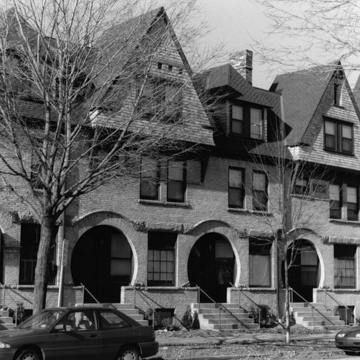Friedmann Row is unusual on two counts. Of the rows that once clustered on Milwaukee’s lower east side, this is one of the few that survive and is also a rare example in Queen Anne style. Normally, the rhythmic, repetitive appearance imposed by the row house format precluded the asymmetrical massing and irregularly shaped roofs that typify Queen Anne design. But here Holbrook struck an elegant compromise, alternating dormers and gables on the roofline, repeating horseshoe-arched portals, and placing a tent-roofed tower at the corner. As a result, the composition achieves a row house–like rhythm, and yet each unit resembles an asymmetrically massed house, different from its neighbors. Other Queen Anne textural variations include smooth cream brick walls accented by rough limestone lintels and sills and decorative shingle patterning on the gables. Like many row houses of its era, Friedmann Row was built to house upper-middle-class families but was converted to a rooming house. Then, in 1993, new owners rehabilitated Friedmann Row, converting it back into single-family units and restoring much of its original interior and exterior character.
This building’s original owner, Ignatius Friedmann from Austria-Hungary, came to Milwaukee in 1860 and became a successful real estate investor and men’s clothing wholesaler. A leader in the city’s business community, he also worked to advance the arts and served as a principal benefactor of the German-English Academy (MI130).







